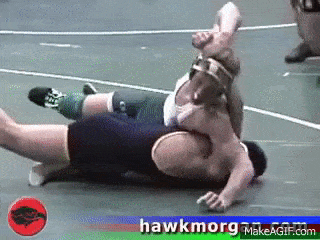
Throw a stone in any Brazilian Jiu-Jitsu gym and you’re likely to hit someone attempting a guillotine on their training partner. The guillotine choke is all over grappling, a real staple in no-gi and making its way even into gi circuits. However, there is a guillotine move version out there called the wrestling guillotine which has nothing to do with the front headlock choke we know and love in Jiu-Jitsu but has a lot to offer.
The Original Guillotine
While many grapplers and combat sports athletes think of the guillotine purely as a choke, mostly from the front headlock position when they hear the word “guillotine”, the wrestling guillotine actually has nothing to do with it. It is a move that wrestlers use to pin their opponent to the ground rather than get a tap.
A pin in wrestling is when both shoulder blades of one person touch the mats and stay there for three seconds. Just like submissions in BJJ, pins immediately win the match for the grappler executing the move.
The wrestling guideline provides a very strong pinning position, which is something we’re constantly after in BJJ.
The move was originally founded by Ralph Leander Lupton in the 1920s. The Cornell 1928 NCAA champion managed to figure out a way to pin someone from the referee’s position by manipulating the upper body.
The Wrestling Guillotine Pin
The wrestling guillotine is mostly taught at the high school level but works at every level of wrestling, BJJ, and MMA. In Brazilian JIu-Jitsu, there is a version of the wrestlers guillotine that most people will recognize as Eddie Bravo’s Twister. However, it is not really the same as the original wrestling guillotine and offers different options for that attacker.
So, what is the Guillotine move in wrestling?
- The wrestling guillotine starts when someone is in the referee’s position (or turtle, in BJJ lingua).
- The top person first weaves the near-side leg through the opponent’s legs, blocking their near-side leg.
- The far side arm is the next target, usually starting with a biceps-to-biceps grip to elevate the arm, before passing the arm behind the head, while sneaking the near-side arm in.
- The near-sidearm of the top person then goes around the opponent’s head and the move is set.
- Getting the pin requires the person doing the wrestling guillotine to roll forward over the arm that is not holding the opponent’s head. This should result in an immediate pin, bringing both the opponent’s shoulders to the mats.
https://www.youtube.com/watch?v=sLRdigvlhmw
As you can see this move is completely different from the guillotine choke, like for example high elbow guillotine that we usually do in BJJ.
That raises a common question can you guillotine choke in wrestling? The answer is no. Apart from catch wrestling, no version of wrestling allows submission holds, including chokes.
The funny thing is that the wrestlers guillotine is not allowed in BJJ (some versions of it)as it constitutes a neck crank. However, there is an application for both moves in the grappling sports which ban them, as long as you approach them with a few key adjustments.
The Wrestler’s Guillotine vs. Eddie Bravo’s Twister
Eddie Bravo’s famous Twister is a move he invented inspired by the wrestling guillotine. The Twister is a purposeful neck/spine crank though, which makes it useless under most BJJ rules.
The subtle differences between the Twister and the wrestling guillotine mean that you can actually get all of the pinning benefits of this move with none of the risks of using illegal moves which could get you DQed.
- The legs during a twister entangle the opponent in a triangle, which makes it difficult for them to wiggle out, as opposed to the wrestlers guillotine where only the initial hook with the leg is in.
- The arm positioning, in terms of acquiring the grip around the head, is much more methodical in Eddie’s Twister, but only up to the point of getting a hold of the head. If This is the grey zone of neck cranks, so if you purely want to pin, using the setup by getting the hand position in from the top, like in wrestling will clear things up rule-wise.
- Finally, the goal of the position in the Twister is to submit, while in the wrestling guillotine, it is to get both shoulder blades on the mats. Pinning the shoulders to the mats is extremely useful in BJJ as well and this move offers a different way of pinning someone, leaving transitions to mount, side control, and the back all available at the same time.
Wrestling Guilltine Variations And Applications For Jiu-Jitsu
The regular wrestling guillotine is going to work like charm every time you sneak a leg in against a turtled up opponent. Moreover, you can use the half guard to force people into their position, since your leg is already in at that point.
The best utilization is to pin like in wrestling, carefully dropping the opponent on their back. Once there you can opt to mount easily, use side control if the opponent tries to wiggle out, or transition into the back, or some 10th Planet Jiu-Jitsu positions like the Truck.
Getting banana split submissions is also an option when you can’t reach the far sidearm against t a person in turtle. Instead, you can use the single leg ride you have (hook with your leg on theirs) to drop down to a calf slicer/banana split position which will help you either tap the opponent out, to make them leave the turtle position and get your pin.
Final Thoughts
Wrestling is a big help when it comes to BJJ, and not just in the sense of takedowns. Things like the wrestling guillotine are irreplaceable when it comes to pinning people in place and taking a breath while having a multitude of options open. Just make sure to resist the urge to do a Twister and keep things legal.


![Darce Choke Encyclopedia – Origins, Mechanics and Variations [2025] BJJ, choke, Brabo, BJJ Darce Choke, D'arce Choke, Darce BJJ Choke](https://bjj-world.com/wp-content/uploads/2017/11/JungPoirierLeeYahoo-218x150.jpg)












![X-Guard Trickery Kyle Sleeman DVD Review [2025] X-Guard Trickery Kyle Sleeman DVD Review](https://bjj-world.com/wp-content/uploads/2025/03/x-guard-trickery-kyle-sleeman-dvd-review-218x150.png)
![Countering with Crab Ride Anthony Budion DVD Review [2025] Countering with Crab Ride Anthony Budion DVD Review](https://bjj-world.com/wp-content/uploads/2025/03/countering-with-crab-ride-anthony-budion-dvd-review-218x150.png)
![Closet Closed Guard Craig Jones DVD Review [2025] Closet Closed Guard Craig Jones DVD Review](https://bjj-world.com/wp-content/uploads/2025/03/closet-closed-guard-craig-jones-dvd-review-218x150.png)
![Xanadu Back Takes Levi Jones-Leary DVD Review [2025] Xanadu Back Takes Levi Jones-Leary DVD Review](https://bjj-world.com/wp-content/uploads/2025/03/xanadu-back-takes-levi-jones-leary-dvd-review-218x150.png)

![No-Gi Grapplers Guide To Front Headlock Joel Bane DVD Review [2025] No-Gi Grapplers Guide To Front Headlock Joel Bane DVD Review](https://bjj-world.com/wp-content/uploads/2025/03/no-gi-front-headlock-joel-bane-dvd-review-218x150.png)
![Get Off My Legs Gringo Craig Jones DVD Review [2025] Get Off My Legs Gringo Craig Jones DVD Review](https://bjj-world.com/wp-content/uploads/2025/03/get-off-my-legs-gringo-craig-jones-dvd-review-324x235.png)
![Assassin Choke Baret Yoshida DVD Review [2024] Assassin Choke Baret Yoshida DVD Review](https://bjj-world.com/wp-content/uploads/2024/10/assassin-choke-baret-yoshida-dvd-review-100x70.png)
![Dubious De La Riva Dominique Bell DVD Review [2024] Dubious De La Riva Dominique Bell DVD Review](https://bjj-world.com/wp-content/uploads/2024/10/dubious-de-la-riva-dominique-bell-dvd-review-100x70.png)
![Compass Kneebar System Charles Harriott DVD Review [2024] Compass Kneebar System Charles Harriott DVD Review](https://bjj-world.com/wp-content/uploads/2024/11/compass-kneebar-system-charles-harriott-dvd-review-100x70.png)
![EMU Guard 2.0 Benjamin Power DVD Review [2024] EMU Guard 2.0 Benjamin Power DVD Review](https://bjj-world.com/wp-content/uploads/2024/11/emu-guard-2-0-benjamin-power-dvd-review-100x70.png)

![Finish on the Back Ethan Crelinsten DVD Review [2024] Finish on the Back Ethan Crelinsten DVD Review](https://bjj-world.com/wp-content/uploads/2024/10/finish-on-the-back-ethan-crelinsten-dvd-review-100x70.png)
![Neil Melanson DVD Bundle Review: Filthy Brutal No Good Attacks [2024] Neil Melanson DVD Bundle Review: Filthy Brutal No Good Attacks](https://bjj-world.com/wp-content/uploads/2024/10/neil-melanson-dvd-bundle-review-filthy-attacks-100x70.png)

![Just Pass Jay Rodriguez DVD Review [2024] Just Pass Jay Rodriguez DVD Review](https://bjj-world.com/wp-content/uploads/2024/11/just-pass-jay-rodriguez-dvd-review-100x70.png)

![BJJ Foundations Mikey Musumeci DVD Bundle Review [2024] BJJ Foundations Mikey Musumeci DVD Bundle Review](https://bjj-world.com/wp-content/uploads/2024/09/bjj-foundations-mikey-musumeci-dvd-bundle-review-100x70.png)
![Shotgun Aoki Locks Mateusz Szczecinski DVD Review [2025] Shotgun Aoki Locks Mateusz Szczecinski DVD Review](https://bjj-world.com/wp-content/uploads/2025/03/shotgun-aoki-locks-mateusz-szczecinski-dvd-review-100x70.png)
![Grappling Takedown Dominance Brandon Ruiz DVD Review [2025] Grappling Takedown Dominance Brandon Ruiz DVD Review](https://bjj-world.com/wp-content/uploads/2025/01/grappling-takedown-dominance-brandon-ruiz-dvd-review-100x70.png)
![Spider and Lasso Guard Jared Welman DVD Review [2025] Spider and Lasso Guard Jared Welman DVD Review](https://bjj-world.com/wp-content/uploads/2025/01/spider-and-lasso-guard-jared-welman-dvd-review-100x70.png)

![Gracie Secrets Closed Guard Kyra Gracie DVD Review [2024] Gracie Secrets Closed Guard Kyra Gracie DVD Review](https://bjj-world.com/wp-content/uploads/2024/12/closed-guard-kyra-gracie-dvd-review-100x70.png)
![Crossing and Spinning Steps To Attack Israel Hernandez DVD Review [2024] Crossing and Spinning Steps To Attack Israel Hernandez DVD Review](https://bjj-world.com/wp-content/uploads/2024/09/spinning-steps-to-attack-israel-hernandez-dvd-review-100x70.png)


![Intro To Hip Mobility for Guard Players Joshua Presley DVD Review [2024] Intro To Hip Mobility for Guard Players Joshua Presley DVD Review](https://bjj-world.com/wp-content/uploads/2024/09/hip-mobility-for-guard-joshua-presley-dvd-review-100x70.png)
![Jeff Glover Deep Half Revolution DVD Bundle Review [2024] Jeff Glover Deep Half Revolution DVD Bundle Review](https://bjj-world.com/wp-content/uploads/2024/10/jeff-glover-deep-half-revolution-dvd-bundle-review-100x70.png)
![Zen Guide To Submission Grappling Margot Ciccarelli DVD Review [2025] Zen Guide To Submission Grappling Margot Ciccarelli DVD Review](https://bjj-world.com/wp-content/uploads/2025/02/submission-grappling-margot-ciccarelli-dvd-preview-100x70.png)

![Front Head Lock Kaynan Duarte DVD Review [2025] Front Head Lock Kaynan Duarte DVD Review](https://bjj-world.com/wp-content/uploads/2025/02/front-head-lock-kaynan-duarte-dvd-review-100x70.png)


![Simplify the System Side Scissor Brian Glick DVD Review [2024] Simplify the System Side Scissor Brian Glick DVD Review](https://bjj-world.com/wp-content/uploads/2024/09/side-scissor-brian-glick-dvd-review-2024-100x70.png)
![Mastering Takedown Prevention Steve Mocco DVD Review [2024] Mastering Takedown Prevention Steve Mocco DVD Review](https://bjj-world.com/wp-content/uploads/2024/11/mastering-takedown-prevention-steve-mocco-dvd-review-100x70.png)
![Full Guard Formula James Booth DVD Review [2025] Full Guard Formula James Booth DVD Review](https://bjj-world.com/wp-content/uploads/2025/02/full-guard-formula-james-booth-dvd-review-100x70.png)